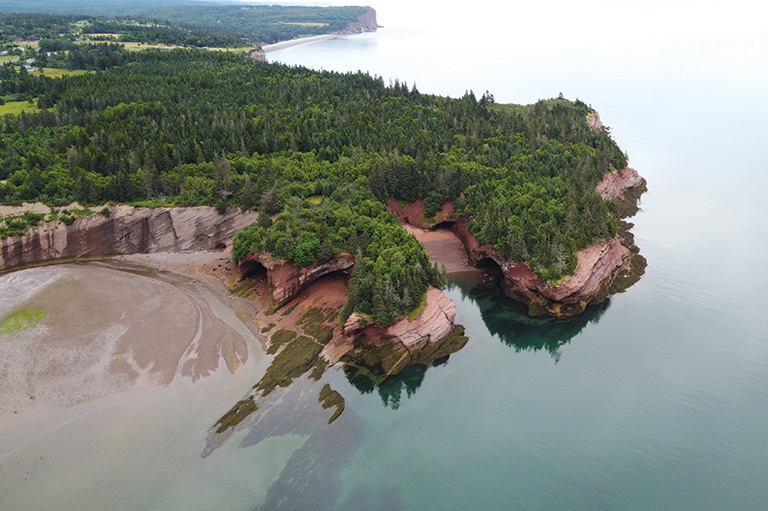The Fur Frontier

“History should be learned through the soles of our feet.” These words are found at the head of the newly opened Hudson’s Bay Company heritage trail, a seventy-five-kilometre route that allows hikers to follow the path fur traders took between the interior and the coast in the mid-1800s, in what is now British Columbia.
I crunch up a steep incline past the textured trunks of conifers and wonder how two hundred horses, carrying nearly eighty-two kilograms of trade goods — tobacco, guns, tools, and food — made it up this trail. I trip on a rock and imagine the brigades stumbling down these slopes with a winter’s worth of valuable lynx, marten, and beaver furs.
This five-day destination trail, with all the backcountry modern conveniences — tent pads, outhouses, and benches — leads hikers between two little-known B.C. historical hotspots, Hope and Tulameen.
Hope Mountain Centre director Kelly Pearce, who along with Kelley Cook of Princeton, B.C., spearheaded the six-year project, hopes the trek will end up on the bucket lists of hikers who seek out experiences like the province’s West Coast Trail.
Finding and rehabilitating the mid-nineteenth-century route began with the work of Harley Hatfield, an Okanagan Similkameen Parks Society member, who pored over old maps and documents in the 1960s and 1970s. He lived by his words, now immortalized on the trailhead sign, and learned from direct observation, too.
The trail offers an alpine adventure and helps to reveal important truths about the fur trade. Some people think First Nations were exploited during this early history, Pearce says.

But she believes Indigenous peoples “still had real power and sovereignty over their traditional territories prior to the [1858] gold rush, when thousands of outsiders suddenly arrived. The fur trade required close co-operation, intermarriage, and economic trade that benefited both groups.”
First Nations were experienced traders and were invaluable in assisting the Xwelitem (hungry ones, in Halq’eméylem, the language of the Stó:lō) get settled in the area.
At Fort Langley, which opened on the banks of the Fraser River in 1827, local high-ranking daughters ended up marrying fur traders and solidifying relationships that were beneficial to both parties.
The fur-focused HBC even adapted its trading strategies to accommodate the salmon and wild-harvested cranberries that the nearby Kwantlen brought to the exchange.
As a result, the salted salmon market became so popular in Hawaii that lomi-lomi, a tomato and salmon salad, is still required eating at every luau.
The HBC would never have found the trail I’m hiking without First Nations allies. According to Pearce, a Similkameen chief named Blackeye showed the HBC his hunting territory and helped to shape the backbone of the trail.
I search for signs of history as I walk. Pearce says you can see blazes gouged five centimetres deep into tree trunks and sections where the trail is worn more than half a metre deep into the terrain. But the chestbusting switchbacks divert my attention.
The Hope-to-Tulameen route helped to keep the area in British hands and set the scene for Canada’s eventual creation, says Pearce. An easier path to travel along the wide and winding Columbia River was abandoned when the Oregon Treaty marked the forty-ninth parallel as the United States border.
The first all-British route pioneered in 1848 led brigades along the jagged mountaintops above the unnavigable Fraser River. Look in hiking guides for the First Brigade Trail or for Tikwalus Trail at Alexandra.
Total losses that year included seventy horses and twenty-five bundles of merchandise.

I reach the top of the mountain at Deer Camp, or Camp de Chevreuil, the second overnight stop for the brigades, and think of the many indigenous people and company men who worked together on this trail in the early days.
The Hudson’s Bay Company’s role waned after British Columbia became a colony in 1858 and more settlers moved in. Soon the First Nations were pushed onto tiny reserves while the newcomers, with their notions of “progress,” claimed more and more territory.
Many of these stories can be found on signs along the trail. But, since I’m learning history through my feet, I figure I’ve got a lot more walking ahead and a lot more to learn.
If you go, visit www.hopemountain.org for maps and the history of the trail.
Themes associated with this article
Advertisement




